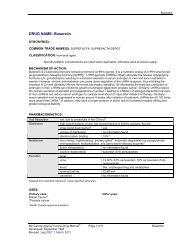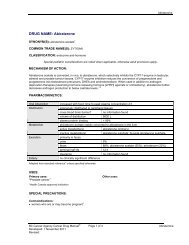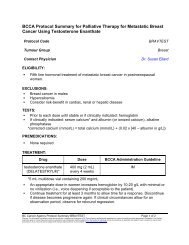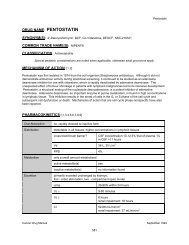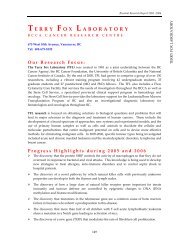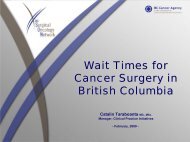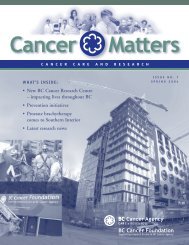Symptom Management Guidelines: CANCER RELATED NAUSEA ...
Symptom Management Guidelines: CANCER RELATED NAUSEA ...
Symptom Management Guidelines: CANCER RELATED NAUSEA ...
Create successful ePaper yourself
Turn your PDF publications into a flip-book with our unique Google optimized e-Paper software.
Consequences• Dehydration• Aspiration pneumonia• Malnutrition• Anorexia• Wound dehiscence• Esophageal tears• Chemotherapy dose delays, reductions, discontinuations of treatment• Quality of life – distress, compromised role function, decreased functional status, exacerbation of other symptoms (e.g.pain, fatigue, sleep-wake disturbance)Focused Health AssessmentGENERAL ASSESSMENT SYMPTOM ASSESSMENT PHYSICAL ASSESSMENTContact and GeneralInformation• Physician name -oncologist, familyphysician• Pharmacy• Home health care• Other healthcareproviders• AllergiesConsider ContributingFactors• Cancer diagnosis andtreatment(s) – note typeand date of last treatment• Medical history• Medication profile• Recent lab or diagnosticreportsNormal• Did you have nausea/vomiting prior to your treatmentstarting?Onset• When did the nausea and/or vomiting begin?• How many episodes of vomiting in the last 24 hours?Provoking / Palliating• What brings on the nausea and/or vomiting?• Is there anything that makes the nausea/vomitingbetter? Worse?Quality• Describe the emesis? – Colour (visible blood, coffeeground emesis, bile)? Volume (large or smallamounts)? Odour?Region / Radiation - NASeverity / other <strong>Symptom</strong>s• How bothered are you by this symptom? (On a scaleof 0 – 10, with 0 being not at all and 10 being theworse imaginable)• What is the daily intake and output?• Do you have nausea with or without vomiting?• Have you had any other symptoms such as:- Abdominal cramping? Stomach pain? Gas pain?- Constipation? - When was your last bowelmovement?- Fever? - possible infection- Dry mouth, thirst, dizziness, weakness, darkurine? – possible dehydration- Blood, mucous in stoolTreatment• What medications or treatments have you tried? Hasthis been effective?Understanding / Impact on You• Are you able to keep fluids down? What are youdrinking? How much?• What do you believe is causing your nausea?Vital Signs• Frequency – as clinicallyindicatedWeight• Take current weight andcompare to pre –treatment or last recordedweightHydration Status• Assess skin turgor,capillary refill, mucousmembranes• Amount and character ofurineAbdominal Assessment• Auscultate abdomen -assess presence andquality of bowel sounds• Assess for abdominalpain, tenderness,distentionEmesis Examination• Inspect emesis for colour,consistency, quantity,odour and bloodThe information contained in these documents is a statement of consensus of BC Cancer Agency professionals regarding their views of currently accepted approaches totreatment. Any clinician seeking to apply or consult these documents is expected to use independent medical judgement in the context of individual clinical circumstances todetermine any patient's care or treatment. Use of these documents is at your own risk and is subject to BC Cancer Agency's terms of use, available atwww.bccancer.bc.ca/legal.htm.Page 2 of 8
<strong>NAUSEA</strong> AND VOMITING GRADING SCALEAdapted from NCI CTCAE (Version 4.03)Normal GRADE 1(Mild)Nausea Non -symptomatic Loss of appetitewithout alterationin eating habitsVomiting No emesis 1-2 episodes(separated by 5minutes) in 24hoursGRADE 2(Moderate)Oral intakedecreased withoutsignificant weightloss, dehydrationor malnutrition3-5 episodes(separated by 5minutes) in 24 hrsGRADE 3(Severe)Inadequate oralcaloric or fluidintake; tubefeedings, TPN orhospitalizationmay be indicated≥ 6 episodes(separated by 5minutes) in 24 hrs;tube feeding, TPNor hospitalizationindicatedGRADE 4(LifeThreatening)Life-threateningconsequences;urgent interventionindicated*Step-Up Approach to <strong>Symptom</strong> <strong>Management</strong>:Interventions Should Be Based On Current Grade Level and Include Lower Level GradeInterventions As AppropriateNORMAL – GRADE 1GRADE 2 ORNausea and Vomiting NOT resolving after 24hoursNON – URGENTPrevention, support, teaching, & follow-up as clinicallyindicatedPatient Care andAssessmentURGENT:Requires medical attention within 24 hours• Rule out other causes of nausea and vomiting• Collaborate with physician if further investigation warranted• Assess need for hospital admission• Assess for nausea and vomiting prior to each chemotherapy, radiation treatment or clinicvisit. If an inpatient, assess daily• Lab tests that may be ordered: CBC and electrolyte profile• If anticipatory nausea, consider distraction strategies such as relaxation, music, imagery orhypnosis (referral to patient and family counseling may be helpful for these interventions)• Consider acupressure-patient administeredThe information contained in these documents is a statement of consensus of BC Cancer Agency professionals regarding their views of currently accepted approaches totreatment. Any clinician seeking to apply or consult these documents is expected to use independent medical judgement in the context of individual clinical circumstances todetermine any patient's care or treatment. Use of these documents is at your own risk and is subject to BC Cancer Agency's terms of use, available atwww.bccancer.bc.ca/legal.htm.Page 3 of 8
Dietary <strong>Management</strong>Encourage:• Frequent small meals in a relaxing environment• Eating foods cold or at room temperature• Appealing foods, even if not usual diet• Increased fluids- aim for 8- 10 cups per day: 2 to 2.5 litres a day (e.g. sports drinks, broth,popsicles, water)• Assistance with food preparation• Restricting fluids with meals• Eating at least one hour before treatment• Continue dietary recommendations until symptoms resolveAvoid:• alcohol and tobacco• foods or fluids that are spicy, acidic, salty, hard or crunchy• lying down after eatingNOTE: If patient unable to tolerate adequate daily fluid intake, IV hydration to replace lostfluid and electrolytes may be required• For further Dietary <strong>Management</strong> See Oncology Nutrition Services in Resource SectionNON – URGENTPrevention, support, teaching, & follow-up as clinicallyindicatedPharmacological<strong>Management</strong>Patient EducationFollow-UpURGENT:Requires medical attention within 24 hours• Avoid or discontinue any medications that may cause or exacerbate nausea and vomiting (inconsultation with physician and pharmacist)• Instruct patient to initiate or continue medications according to instructions given• Allow 30-60 minutes post antiemetic before eating• Antiemetic medications that may be prescribed:– Ondansetron, dexamethasone, metoclopramide, prochlorperazine– Aprepitant for highly emetogenic chemotherapy– Haloperidol– Nozinan– Dimenhydrinate suppository if unable to take orally– Lorazepam may be prescribed for anticipatory nausea• For further Pharmacological <strong>Management</strong> See Cancer <strong>Management</strong> <strong>Guidelines</strong> (HealthProfessional) and Cancer Drug Manual in Resource SectionReinforce importance of accurately recording and reporting the following information:• Onset and number of emesis occurrences per 24 hours• Fluid intake per 24 hours• Reinforce with patients when to seek immediate medical attention:- Temperature greater than or equal to 38° C- Blood (bright red or black) in emesis, coffee ground emesis- Severe cramping, acute abdominal pain (+/- nausea & vomiting)- Dizziness, weakness, confusion, excessive thirst, dark urine- Projectile vomiting- Nausea and vomiting not improving with recommended strategiesReview contact numbers and access to resourcesPatients to be re-assessed within 24 hours:If symptoms not resolved at this time, provide further recommended strategies and repeat follow–up assessment within 24 hours.• Follow up options:- Instruct patient/family to call back- Arrange for nurse initiated telephone follow–up- Physician follow–up in ambulatory care setting may be indicatedThe information contained in these documents is a statement of consensus of BC Cancer Agency professionals regarding their views of currently accepted approaches totreatment. Any clinician seeking to apply or consult these documents is expected to use independent medical judgement in the context of individual clinical circumstances todetermine any patient's care or treatment. Use of these documents is at your own risk and is subject to BC Cancer Agency's terms of use, available atwww.bccancer.bc.ca/legal.htm.Page 4 of 8
GRADE 3 - GRADE 4EMERGENT:Requires IMMEDIATE medical attentionPatient Assessment • Patients with Grade 3 or 4 nausea and vomiting generally require admission to hospital –notify physician of assessment, facilitate arrangements as necessary• Consult with physician- To rule out other causes or concomitant causes of nausea and vomiting- To hold chemotherapy until symptoms resolved.• Lab tests that may be ordered:- Complete blood count (CBC), electrolyte profile• Nursing Support- Monitor vital signs (as clinically indicated)- Physical assessment- Accurate intake and output record, include daily weight- Pain and symptom assessment and management as appropriateDietary <strong>Management</strong> • IV hydration to replace lost fluids and electrolytes• Enteral or parenteral nutrition (TPN) may be indicated for some patients• For further Dietary <strong>Management</strong> See Oncology Nutrition Services in Resource SectionPharmacological<strong>Management</strong>• Avoid/discontinue any medications that may cause or exacerbate nausea and vomiting (inconsultation with physician and pharmacist).• Medications that may be prescribed intravenously:- Ondansetron (Zofran)- Metoclopromide- Prochlorperazine (Stemetil)- Haloperidol- Nozinan- Dexamethasone• For further Pharmacological <strong>Management</strong> See Cancer <strong>Management</strong> <strong>Guidelines</strong> (HealthProfessional) and Cancer Drug Manual in Resource SectionPatient Education • Provide support, reinforce to patients/family that nausea and vomiting can be effectivelymanaged with prompt intervention.• Continue to reinforce self care, review medications, lab /diagnostic testing withpatients/family as appropriate• Discharge teaching as early as possible with patient/familyThe information contained in these documents is a statement of consensus of BC Cancer Agency professionals regarding their views of currently accepted approaches totreatment. Any clinician seeking to apply or consult these documents is expected to use independent medical judgement in the context of individual clinical circumstances todetermine any patient's care or treatment. Use of these documents is at your own risk and is subject to BC Cancer Agency's terms of use, available atwww.bccancer.bc.ca/legal.htm.Page 5 of 8
The information contained in these documents is a statement of consensus of BC Cancer Agency professionals regarding their views of currently accepted approaches totreatment. Any clinician seeking to apply or consult these documents is expected to use independent medical judgement in the context of individual clinical circumstances todetermine any patient's care or treatment. Use of these documents is at your own risk and is subject to BC Cancer Agency's terms of use, available atwww.bccancer.bc.ca/legal.htm.Page 8 of 8




